Study of Discharge Inception and Propagation in Liquid–Solid Insulation System under DC–LI Superimposed Constraints
Abstract
1. Introduction
2. Numerical Modeling
2.1. Geometry
2.2. Applied Voltage Waveforms
2.3. Governing Equations during the DC Voltage Phase
2.4. Governing Equations during the DC-LI Superimposed Voltage Phase
- Field emission charge injection: This is the emission of electrons from the negative electrode under high electric fields. This mechanism is described by the theory of Fowler–Nordheim [41], who developed an equation to describe the electric-field-dependent current density in a vacuum, due to the quantum-mechanical tunneling of electrons from the metal through the potential barrier at the metal–vacuum interface [36];
- Electric-field-dependent ionic dissociation: When applying a high electric field, neutral ion-pairs are dissociated and the free charge concentration is increased. This mechanism is based on the theory of Onsager [42] where the liquid is assumed to contain a certain concentration of ion-pairs and free charges [36];
- Impact ionization: This occurs when an energetic electron undergoes a collision in which an electron in the valence band is promoted to the conduction band, resulting in an additional electron and a positive ion being produced;
- Photoionization: Photoionization is responsible for the photoelectric effect where a photon with high energy is absorbed by an atom or a molecule, which generates an electron.
2.5. Surface Charge Calculation
2.6. Current Calculation
2.7. Boundary Conditions
3. Results and Discussion
3.1. The Process of Surface Charge Accumulation during the DC Voltage Phase
3.2. Streamer Development during the DC–LI Superimposed Voltage Phase
3.3. Study of the Effect of Surface Charge Accumulation on Streamers
3.3.1. Effect on Streamer Initiation
3.3.2. Effect on Streamer Velocity
- When the streamer is traveling in oil (Figure 16a): The streamer velocity in the first case (5.6 km/s) is higher than in the second case with (3.6 km/s). In the second case, the maximum value of the streamer velocity decreases with the increase in the DC voltage. This behavior is caused by the accumulated surface charge that weakens the total electric field and causes streamer velocity peaks to decrease in amplitude. It is worth mentioning that changing the value of necessarily slightly affects the voltage rise time. However, based on simulations where the effect of surface charge was removed, no considerable effect was observed on streamer velocity. As a consequence, the effect of the accumulated charges dominates.
- When the streamer starts traveling along the oil–OIP interface (Figure 16b), the effect of the applied voltage dominates, and the effect of the accumulated surface charge can be neglected. This can be explained by the fact that the surface charges create a vertical electrical field and the streamer propagates horizontally. Knowing that the applied voltage is increasing over time, as the streamer initiation is delayed, the applied voltage when the streamer reaches the interface will be higher. This explains why the first data points of the curves increase as the streamer is delayed. As the streamer continues to propagate further in the interface, its velocity gradually decreases because of the decrease of the electric field as mentioned beforehand.
3.3.3. Effect on Streamer Travel Distance
4. Conclusions
- Increased accumulation of positive surface charge;
- Increased streamer inception voltage that causes further delay in streamer initiation;
- Decreased streamer velocity just before reaching the oil–OIP interface, which increases at the beginning of streamer travel in the interface;
- Decreased streamer travel distance.
- 5.
- Increased accumulation of negative surface charge;
- 6.
- Decreased streamer inception voltage that causes further advance in streamer initiation;
- 7.
- Increased streamer velocity just before reaching the oil–OIP interface, which decreases at the beginning of the streamer travel in the interface;
- 8.
- Increased streamer travel distance.
Author Contributions
Funding
Institutional Review Board Statement
Informed Consent Statement
Data Availability Statement
Conflicts of Interest
References
- S & P Global. Available online: https://www.spglobal.com/en/research-insights/articles/what-is-energy-transition (accessed on 24 October 2022).
- Wang, P.; Goel, L.; Liu, X.; Choo, F.H. Harmonizing AC and DC: A Hybrid AC/DC Future Grid Solution. IEEE Power Energy Mag. 2013, 11, 76–83. [Google Scholar] [CrossRef]
- Adapa, R. High-Wire Act: HVdc Technology: The State of the Art. IEEE Power Energy Mag. 2012, 10, 18–29. [Google Scholar] [CrossRef]
- Bahrman, M.P.; Johnson, B.K. The ABCs of HVDC Transmission Technologies. IEEE Power Energy Mag. 2007, 5, 32–44. [Google Scholar] [CrossRef]
- Flourentzou, N.; Agelidis, V.G.; Demetriades, G.D. VSC-Based HVDC Power Transmission Systems: An Overview. IEEE Trans. Power Electron. 2009, 24, 592–602. [Google Scholar] [CrossRef]
- Yang, J.; Fletcher, J.E.; O’Reilly, J. Short-Circuit and Ground Fault Analyses and Location in VSC-Based DC Network Cables. IEEE Trans. Ind. Electron. 2012, 59, 3827–3837. [Google Scholar] [CrossRef]
- Nakajima, T.; Irokawa, S. A Control System for HVDC Transmission by Voltage Sourced Converters. In Proceedings of the 1999 IEEE Power Engineering Society Summer Meeting. Conference Proceedings (Cat. No.99CH36364), Edmonton, AB, Canada, 18–22 July 1999; Volume 2, pp. 1113–1119. [Google Scholar]
- Kouro, S.; Malinowski, M.; Gopakumar, K.; Pou, J.; Franquelo, L.G.; Wu, B.; Rodriguez, J.; Pérez, M.A.; Leon, J.I. Recent Advances and Industrial Applications of Multilevel Converters. IEEE Trans. Ind. Electron. 2010, 57, 2553–2580. [Google Scholar] [CrossRef]
- Hammons, T.J.; Lescale, V.F.; Uecker, K.; Haeusler, M.; Retzmann, D.; Staschus, K.; Lepy, S. State of the Art in Ultrahigh-Voltage Transmission. Proc. IEEE 2012, 100, 360–390. [Google Scholar] [CrossRef]
- Thind, B.S.; Thomas, A.J.; Reddy, C.C. Effect of Voltage Waveforms of HVDC Converter Transformer on Lifetime Characteristics. IEEE Trans. Power Deliv. 2021, 36, 3101–3108. [Google Scholar] [CrossRef]
- Bhuvaneswari, G.; Mahanta, B.C. Analysis of Converter Transformer Failure in HVDC Systems and Possible Solutions. IEEE Trans. Power Deliv. 2009, 24, 814–821. [Google Scholar] [CrossRef]
- Huang, B.; Hao, M.; Hao, J.; Fu, J.; Wang, Q.; Chen, G. Space Charge Characteristics in Oil and Oil-Impregnated Pressboard and Electric Field Distortion after Polarity Reversal. IEEE Trans. Dielectr. Electr. Insul. 2016, 23, 881–891. [Google Scholar] [CrossRef]
- Zhang, J.; Chi, M.; Chen, Q.; Sun, W.; Cao, J. Effect of Temperature on Space Charge Distribution in Two Layers of Transformer Oil and Impregnated Pressboard Under DC Voltage. IEEE Access 2020, 8, 16647–16655. [Google Scholar] [CrossRef]
- Piovan, U. Insulation Systems for HVDC Transformers: Present Configurations, Trends, Challenges, Solutions and Open Points. In Proceedings of the 2013 IEEE International Conference on Solid Dielectrics (ICSD), Bologna, Italy, 30 June–4 July 2013; pp. 254–257. [Google Scholar]
- Carlson, A. ABB Library-Specific Requirements on HVDC Converter Transformers. Available online: https://library.e.abb.com/public/5f6d61425208b604c1256fda004aeada/Specific%20requirements%20on%20HVDC%20converter%20transformers.pdf (accessed on 24 October 2022).
- Azcárraga, C.G. Partial Discharge Phenomena in Converter and Traction Transformer: Identification and Reliability. Ph.D. Thesis, Università di Bologna, Bologna, Italy, 2014. [Google Scholar]
- Ebisawa, Y.; Yamada, S.; Mori, S.; Teranishi, T. DC Creepage Breakdown Characteristics of Oil-Immersed Insulation. IEEE Trans. Dielectr. Electr. Insul. 2009, 16, 1686–1692. [Google Scholar] [CrossRef]
- Kharezy, M.; Thiringer, T. Challenges with the Design of Cost Effective Series DC Collection Network for Offshore Wind Farm. In Proceedings of the 17th Wind Integration Workshop, Stockholm, Sweden, 17–19 October 2018. [Google Scholar]
- Sun, A.; Huo, C.; Zhuang, J. Formation Mechanism of Streamer Discharges in Liquids: A Review. High Volt. 2016, 1, 74–80. [Google Scholar] [CrossRef]
- Wedin, P. Electrical Breakdown in Dielectric Liquids-a Short Overview. IEEE Electr. Insul. Mag. 2014, 30, 20–25. [Google Scholar] [CrossRef]
- Lesaint, O. “Streamers” in Liquids: Relation with Practical High Voltage Insulation and Testing of Liquids. In Proceedings of the 2008 IEEE International Conference on Dielectric Liquids, Poitiers, France, 30 June–3July 2008; pp. 1–6. [Google Scholar]
- Beroual, A.; Zahn, M.; Badent, A.; Kist, K.; Schwabe, A.J.; Yamashita, H.; Yamazawa, K.; Danikas, M.; Chadband, W.D.; Torshin, Y. Propagation and Structure of Streamers in Liquid Dielectrics. IEEE Electr. Insul. Mag. 1998, 14, 6–17. [Google Scholar] [CrossRef]
- Lesaint, O. Prebreakdown Phenomena in Liquids: Propagation `modes’ and Basic Physical Properties. J. Phys. D Appl. Phys. 2016, 49, 144001. [Google Scholar] [CrossRef]
- Akiyama, H. Streamer Discharges in Liquids and Their Applications. IEEE Trans. Dielectr. Electr. Insul. 2000, 7, 646–653. [Google Scholar] [CrossRef]
- Rao, U.M.; Fofana, I.; Beroual, A.; Rozga, P.; Pompili, M.; Calcara, L.; Rapp, K.J. A Review on Pre-Breakdown Phenomena in Ester Fluids: Prepared by the International Study Group of IEEE DEIS Liquid Dielectrics Technical Committee. IEEE Trans. Dielectr. Electr. Insul. 2020, 27, 1546–1560. [Google Scholar] [CrossRef]
- Dumitrescu, L.; Lesaint, O.; Bonifaci, N.; Denat, A.; Notingher, P. Study of Streamer Inception in Cyclohexane with a Sensitive Charge Measurement Technique under Impulse Voltage. J. Electrost. 2001, 53, 135–146. [Google Scholar] [CrossRef]
- Denat, A.; Gosse, J.P.; Gosse, B. Electrical Conduction of Purified Cyclohexane in a Divergent Electric Field. IEEE Trans. Electr. Insul. 1988, 23, 545–554. [Google Scholar] [CrossRef]
- Bonifaci, N.; Denat, A.; Atrazhev, V. Ionization Phenomenon in High-Density Gaseous and Liquid Argon in Corona Discharge Experiments. J. Phys. D Appl. Phys. 1997, 30, 2717–2725. [Google Scholar] [CrossRef]
- Naidis, G.V. On Streamer Inception in Hydrocarbon Liquids in Point-Plane Gaps. IEEE Trans. Dielectr. Electr. Insul. 2015, 22, 2428–2432. [Google Scholar] [CrossRef]
- Naidis, G.V. Modelling of Streamer Propagation in Hydrocarbon Liquids in Point-Plane Gaps. J. Phys. D Appl. Phys. 2015, 48, 195203. [Google Scholar] [CrossRef]
- Starikovskiy, A.; Yang, Y.; Cho, Y.I.; Fridman, A. Non-Equilibrium Plasma in Liquid Water: Dynamics of Generation and Quenching. Plasma Sources Sci. Technol. 2011, 20, 024003. [Google Scholar] [CrossRef]
- Moufakkir, Y.; Zouaghi, A.; Vollaire, C. Analysis of Electric Field and Surface Discharge in Liquid-Solid Insulation System for HVDC Components. In Proceedings of the 2022 IEEE 21st International Conference on Dielectric Liquids (ICDL), Sevilla, Spain, 29 May–2 June 2022; pp. 1–4. [Google Scholar]
- Zainuddin, H. Study of Surface Discharge Behaviour at the Oil-Pressboard Interface. Ph.D. Thesis, University of Southampton, Southampton, UK, 2013. [Google Scholar]
- IEC 60060-1:2010; High-Voltage Test Techniques—Part 1: General Definitions and Test Requirements. IEC Standard: Geneva, Switzerland, 2010.
- Du, B.; Dong, J.; Liang, H.; Kong, X. Polarity Reversal and Over Voltage Affecting Discharge Inception of Tri-Post Insulator in ±800 KV GIL. IEEE Trans. Dielectr. Electr. Insul. 2022, 29, 223–230. [Google Scholar] [CrossRef]
- O’Sullivan, F.M. A Model for the Initiation and Propagation of Electrical Streamers in Transformer Oil and Transformer Oil Based Nanofluids. Ph.D. Thesis, Massachusetts Institute of Technology, Cambridge, MA, USA, 2007. [Google Scholar]
- Hwang, J.W.G. Elucidating the Mechanisms behind Pre-Breakdown Phenomena in Transformer Oil Systems. Ph.D. Thesis, Massachusetts Institute of Technology, Cambridge, MA, USA, 2010. [Google Scholar]
- Jadidian, J. Charge Transport and Breakdown Physics in Liquid/Solid Insulation Systems. Ph.D. Thesis, Massachusetts Institute of Technology, Cambridge, MA, USA, 2013. [Google Scholar]
- Qian, J.; Joshi, R.P.; Schamiloglu, E.; Gaudet, J.; Woodworth, J.R.; Lehr, J. Analysis of Polarity Effects in the Electrical Breakdown of Liquids. J. Phys. D Appl. Phys. 2006, 39, 359. [Google Scholar] [CrossRef]
- O’Sullivan, F.; Hwang, J.G.; Zahn, M.; Hjortstam, O.; Pettersson, L.; Liu, R.; Biller, P. A Model for the Initiation and Propagation of Positive Streamers in Transformer Oil. In Proceedings of the Conference Record of the 2008 IEEE International Symposium on Electrical Insulation, Bucharest, Romania, 15–19 September 2008; pp. 210–214. [Google Scholar]
- Fowler, R.; Nordheim, L. Electron Emission in Intense Electric Fields. Proc. R. Soc. A Math. Phys. Eng. Sci. 1928, 119, 173–181. [Google Scholar] [CrossRef]
- Onsager, L. Deviations from Ohm’s Law in Weak Electrolytes. J. Chem. Phys. 1934, 2, 599–615. [Google Scholar] [CrossRef]
- Ghassemi, M.; Chen, Q.; Cao, Y. The Influence of Magnitude and Rise Time of Applied Voltage and the Type of Oil on Streamer Growth in a Wet-Mate DC Connector. IEEE Trans. Dielectr. Electr. Insul. 2017, 24, 1646–1656. [Google Scholar] [CrossRef]
- Lundgaard, L.; Linhjell, D.; Berg, G.; Sigmond, S. Propagation of Positive and Negative Streamers in Oil with and without Pressboard Interfaces. IEEE Trans. Dielectr. Electr. Insul. 1998, 5, 388–395. [Google Scholar] [CrossRef]
- Zener, C. A Theory of the Electrical Breakdown of Solid Dielectrics. Proc. R. Soc. London. Ser. A Contain. Pap. A Math. Phys. Character 1934, 145, 523–529. [Google Scholar] [CrossRef]
- Morrow, R.; Sato, N. The Discharge Current Induced by the Motion of Charged Particles in Time-Dependent Electric Fields; Sato’s Equation Extended. J. Phys. D Appl. Phys. 1999, 32, L20–L22. [Google Scholar] [CrossRef]
- Nakane, R.; Kato, K.; Hayakawa, N.; Okubo, H. Time and Space Transition Characteristics of DC Electric Field Stress in Oil-Pressboard Composite Insulation Systems. Electron. Commun. Jpn. 2020, 103, 13–21. [Google Scholar] [CrossRef]
- Ghassemi, M.; Tefferi, M.B.; Chen, Q.; Cao, Y. Modeling a Liquid-Solid Insulation System Used in a DC Wet-Mate Connector. In Proceedings of the 2016 IEEE Conference on Electrical Insulation and Dielectric Phenomena (CEIDP), Toronto, ON, Canada, 16–19 October 2016; pp. 161–166. [Google Scholar]
- Lesaint, O.; Massala, G. Transition to Fast Streamers in Mineral Oil in the Presence of Insulating Solids. In Proceedings of the Conference Record of the 1996 IEEE International Symposium on Electrical Insulation, Montreal, QC, Canada, 16–19 June 1996; Volume 2, pp. 737–740. [Google Scholar]
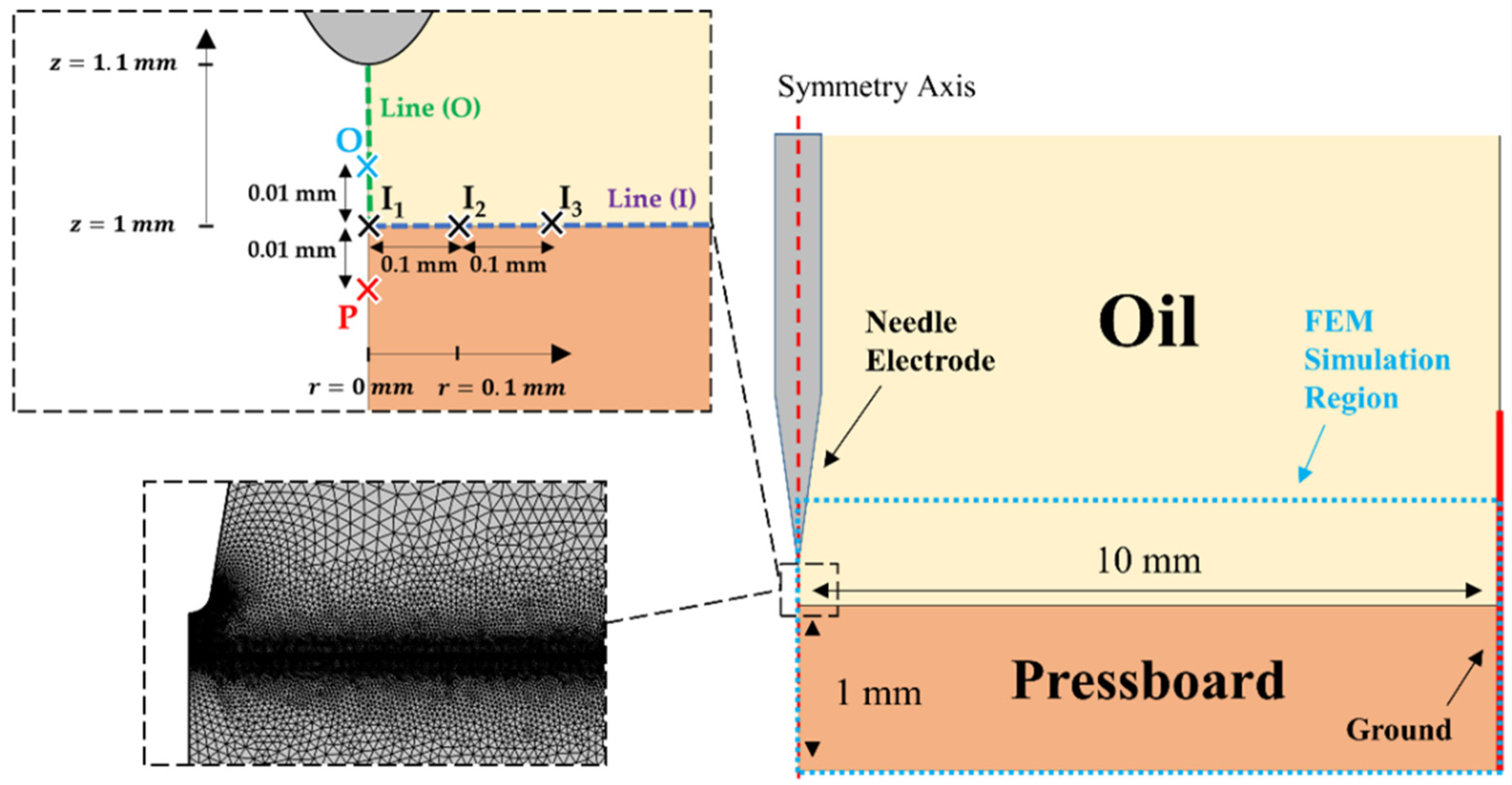




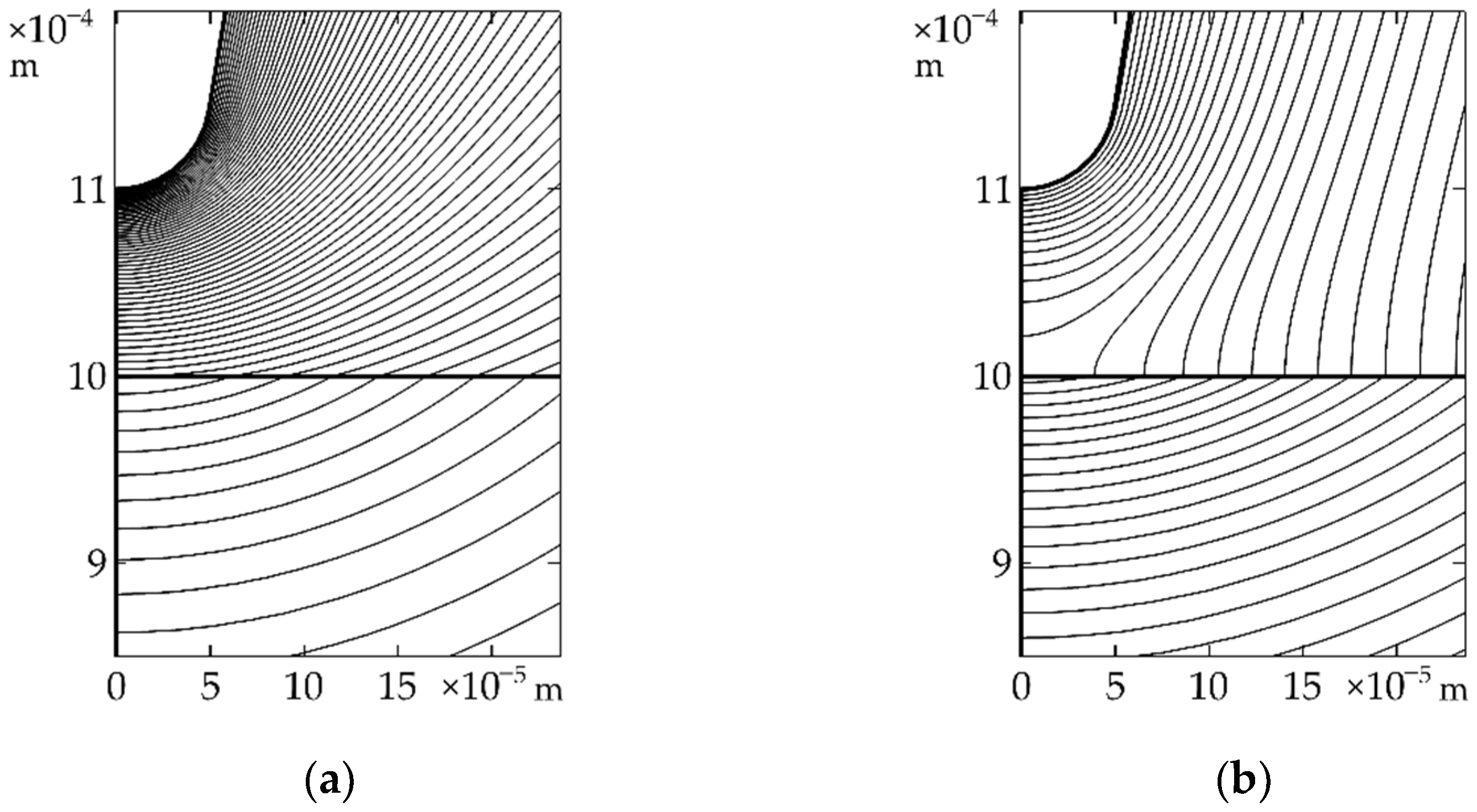



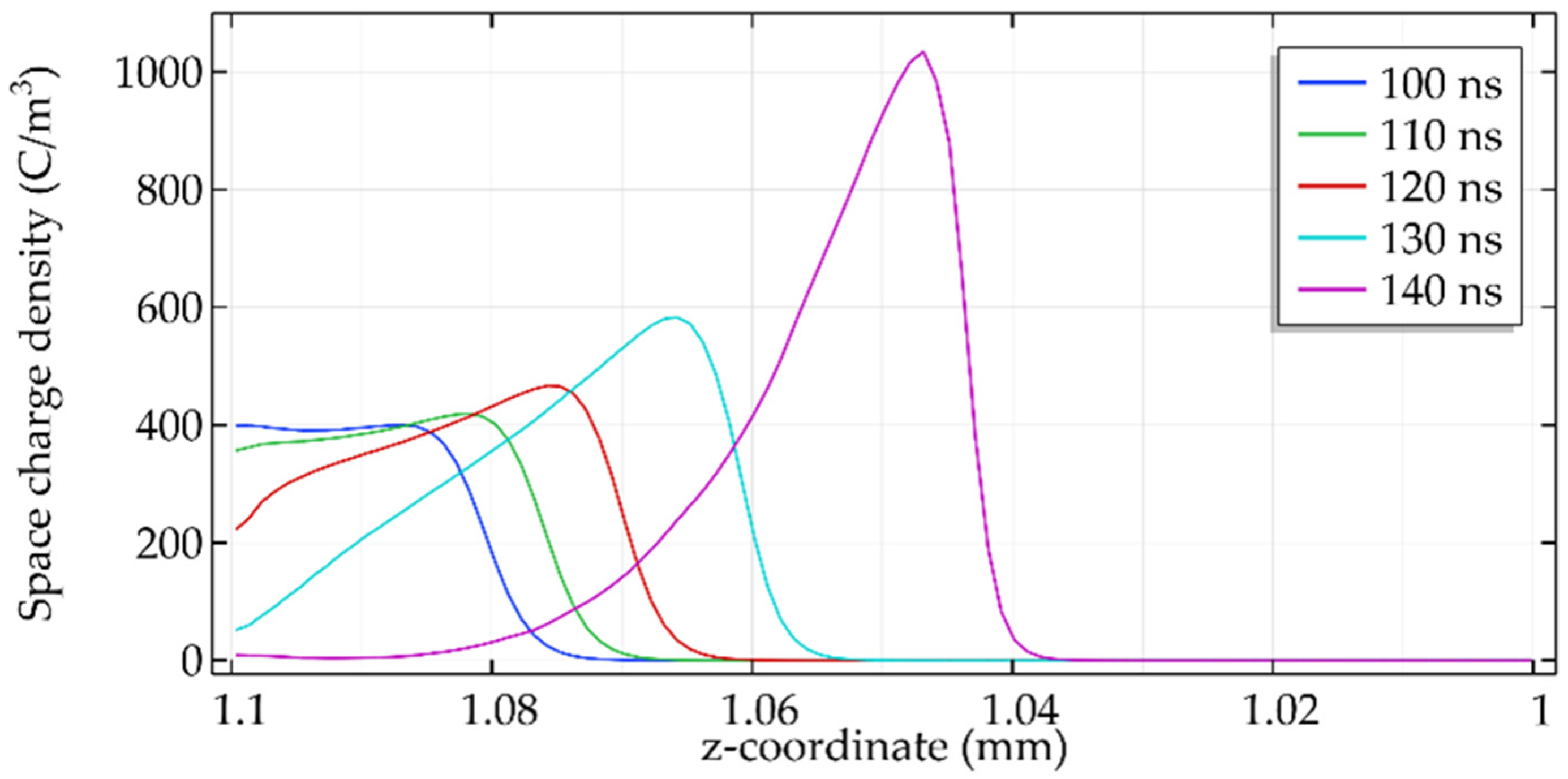


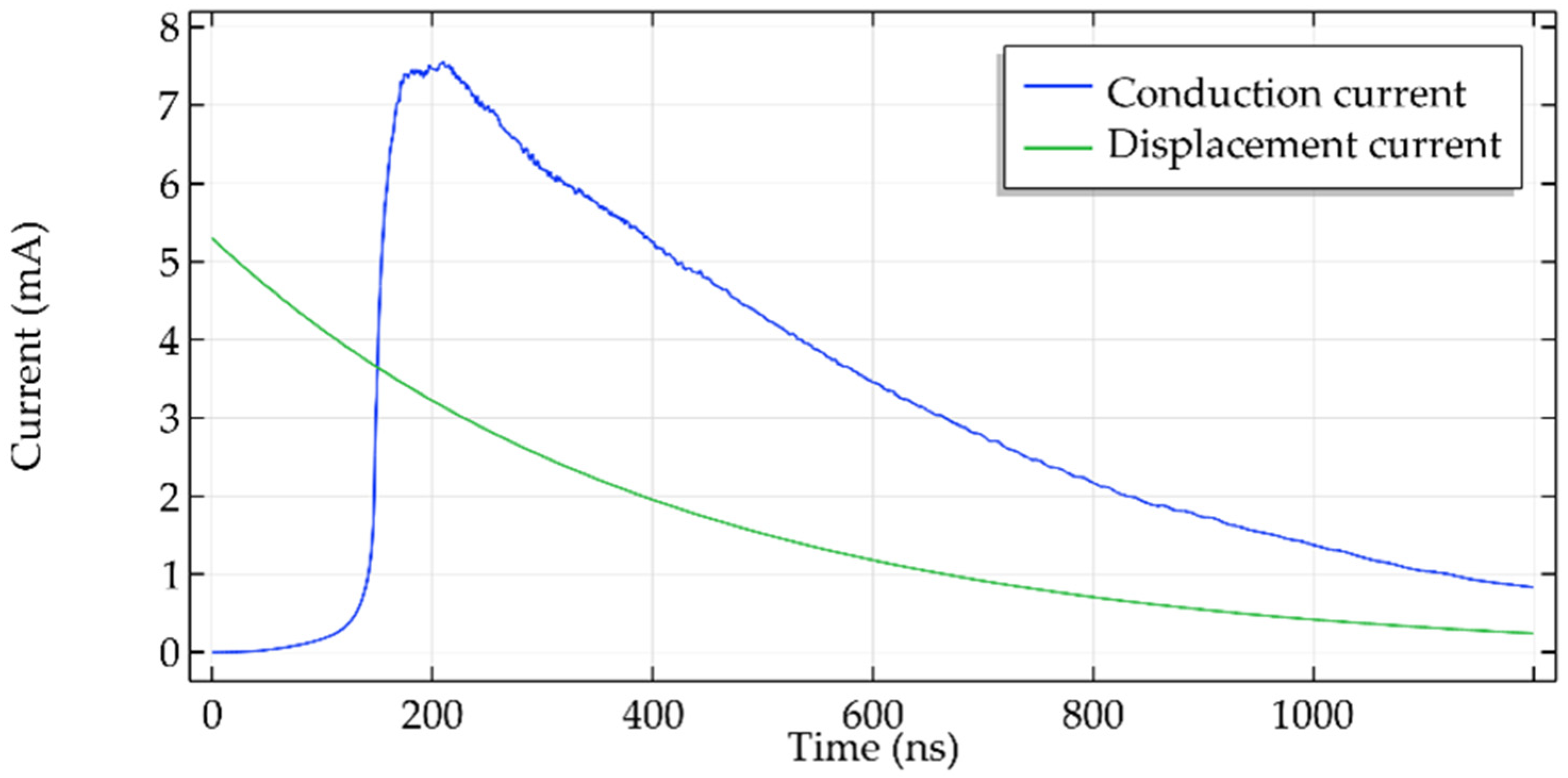

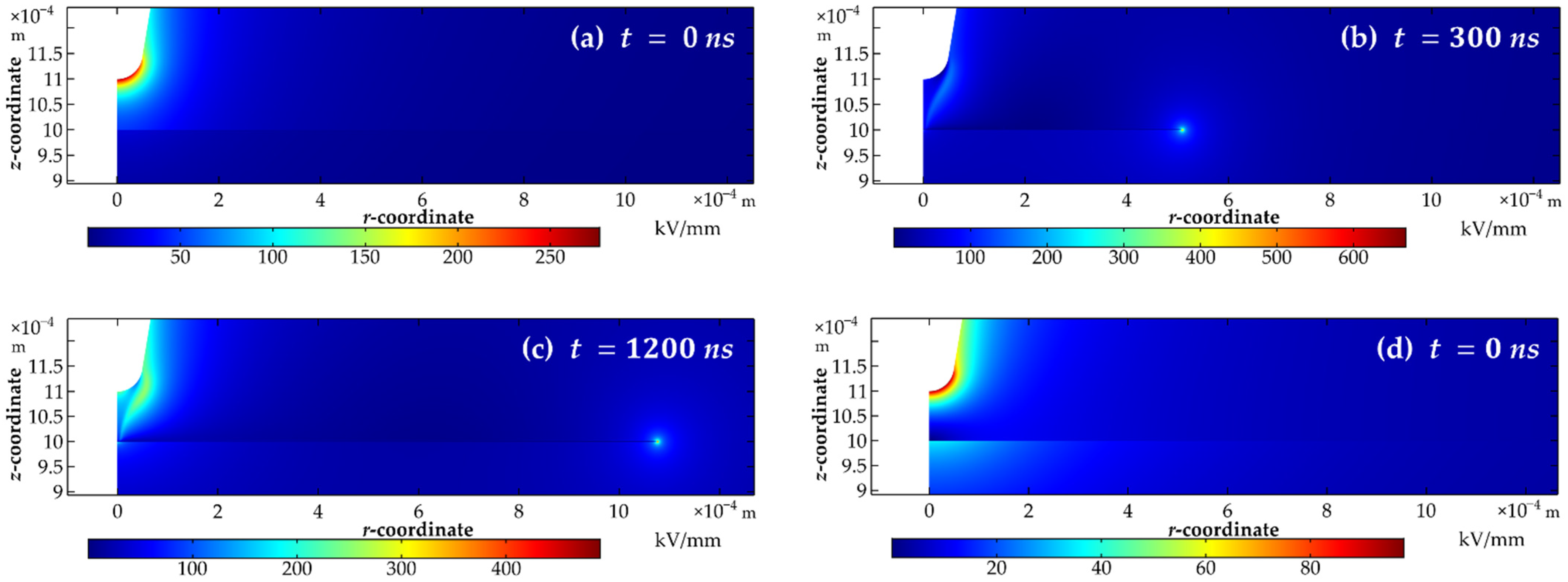



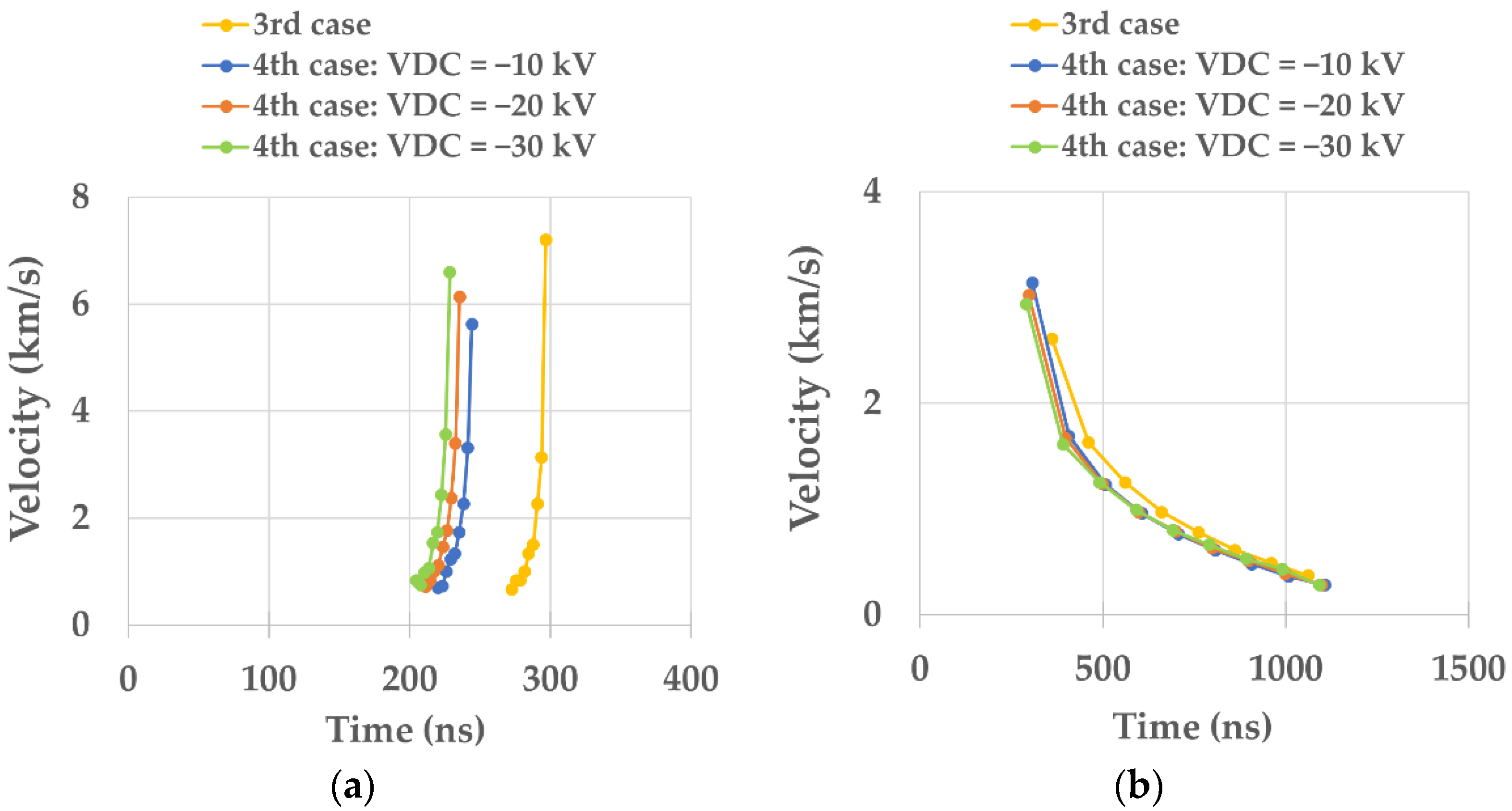
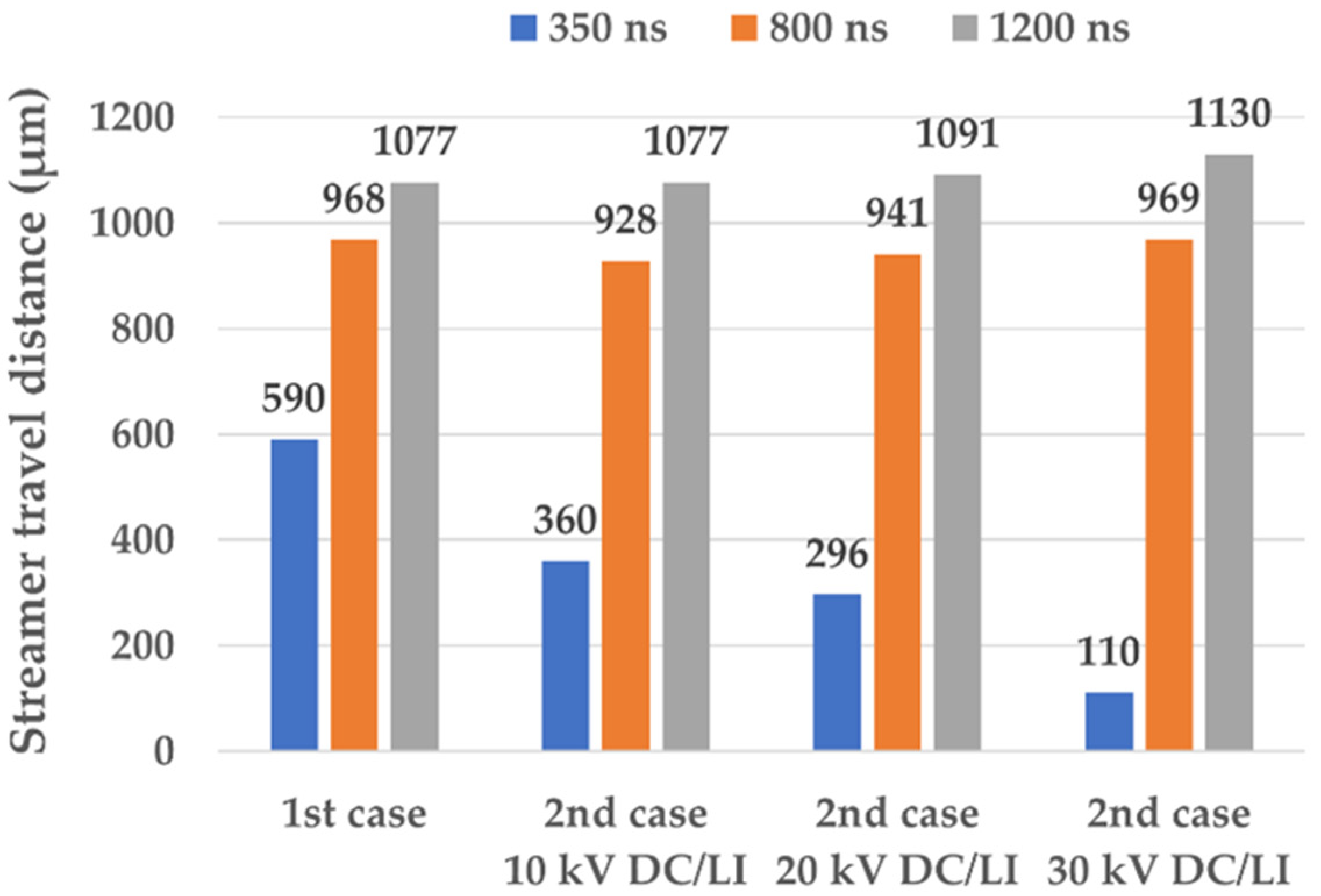

| Parameter | Symbol | Value [33,37,38,40] |
|---|---|---|
| Positive ion mobility | ||
| Negative ion mobility | ||
| Electron mobility | ||
| Ion–ion recombination rate | ||
| Electron–ion recombination rate | ||
| Electron attachment time | ||
| Elementary charge | ||
| Density of ionizable species | ||
| Molecular separation distance | a | |
| Planck’s constant | ||
| Effective electron mass | ||
| Ionization potential |
| Boundary | Electrostatic | Transport of Charge Carriers |
|---|---|---|
| Needle electrode | ||
| Ground | ||
| Oil–OIP interface | Equations (11) and (14) | |
| Outer boundary |
Disclaimer/Publisher’s Note: The statements, opinions and data contained in all publications are solely those of the individual author(s) and contributor(s) and not of MDPI and/or the editor(s). MDPI and/or the editor(s) disclaim responsibility for any injury to people or property resulting from any ideas, methods, instructions or products referred to in the content. |
© 2022 by the authors. Licensee MDPI, Basel, Switzerland. This article is an open access article distributed under the terms and conditions of the Creative Commons Attribution (CC BY) license (https://creativecommons.org/licenses/by/4.0/).
Share and Cite
Moufakkir, Y.; Zouaghi, A.; Vollaire, C. Study of Discharge Inception and Propagation in Liquid–Solid Insulation System under DC–LI Superimposed Constraints. Energies 2023, 16, 172. https://doi.org/10.3390/en16010172
Moufakkir Y, Zouaghi A, Vollaire C. Study of Discharge Inception and Propagation in Liquid–Solid Insulation System under DC–LI Superimposed Constraints. Energies. 2023; 16(1):172. https://doi.org/10.3390/en16010172
Chicago/Turabian StyleMoufakkir, Younes, Ayyoub Zouaghi, and Christian Vollaire. 2023. "Study of Discharge Inception and Propagation in Liquid–Solid Insulation System under DC–LI Superimposed Constraints" Energies 16, no. 1: 172. https://doi.org/10.3390/en16010172
APA StyleMoufakkir, Y., Zouaghi, A., & Vollaire, C. (2023). Study of Discharge Inception and Propagation in Liquid–Solid Insulation System under DC–LI Superimposed Constraints. Energies, 16(1), 172. https://doi.org/10.3390/en16010172






